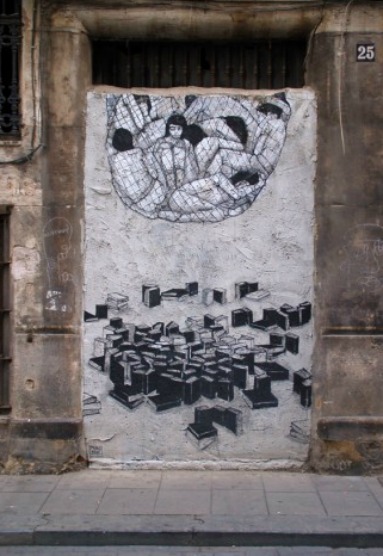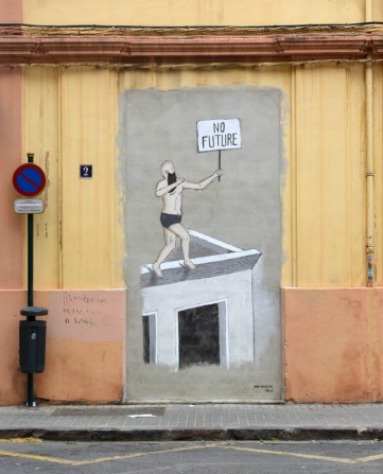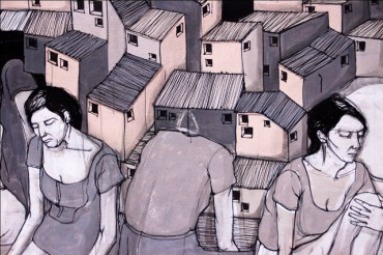A new social epidemic is gripping Spain: the foreclosure suicide
Since last July, about 20 people have killed themselves in the face of imminent eviction.
Suicide is paradigmatic of subalternity. It constitutes the ultimate limit on speech: The protagonist can no longer tell her own story, explain the sequence of experiences that led to the decision, or describe the hesitation of feet at the edge or the joy and terror and speed of the fall. And yet, it is only after death that the act can be brought to life. Only when it has been silenced can that death made sense of, pieced together into a chain of events that says something about the world and how it works. While Spanish activists and politicians have sparred over how best to interpret the suicides, therefore, the tasks of narration and emplotment belong to the writer and historian. Perhaps this is why Talal Asad has suggested in On Suicide Bombing that suicide is intimately tied up with fiction and the desire to craft “plausible histories.”
One way to tell this story would start from the recognition that the suicides bring into sharp relief a set of structural factors that can otherwise be difficult to see with the naked eye. With general unemployment currently at 26 percent — though the figure for youth is more than double that — it isn’t hard to imagine plausible scenarios in which spiraling interest payments converge with ever increasing desperation. Since the financial crisis hit in 2008, foreclosures have skyrocketed: Some 400,000 evictions have taken place, which amounts to hundreds a day. At the same time, the most recent census data shows that between five and six million housing units currently sit empty, approximately 20 percent of the country’s housing stock. In this way, crisis intensifies the structural contradictions of capitalism. The Spanish countryside is now littered with half-built subdivisions, carcasses of concrete, brick, and rebar, the scars of a construction boom fueled by northern European banks.
Spain’s exceptionally harsh mortgage laws are an additional burden. They require debtors to repay their loans in full even after their homes have been repossessed — even death won’t discharge the loan. The laws date back to 1909, and activists, economists, jurists, and academics alike have called them obsolete. “Spain’s mortgage law is over 100 years old and it’s designed in the banks’ favor,” one protester told a Reuters journalist at a recent demonstration outside Congress. “The fact that this legislation is still in place, apart from being unjust and immoral, is anachronistic.” These critics believe that solving the foreclosure crisis will require updating the laws in order to adapt them to the socioeconomic conditions of the 21st century. When the European Union’s highest court struck down parts of the laws in March, even politicians jumped on the bandwagon, with Spanish president Mariano Rajoy vowing to bring the laws — which, as he put it, “date back to many years ago” — into compliance with EU mandates. The new legislation, however, ignores the demands of anti-eviction organizers and apparently leaves the original laws largely unchanged.
But the problem of eviction runs deeper and reaches back further than even the beginning of the 20th century. Modern history starts with eviction.
All modern states can be traced back to some original dispossession, some foundational act of internal or external colonization. Spain, in particular, has built itself on a series of cascading dispossession which dates back, in an uncanny coincidence, to the year 1492. Christopher Columbus himself emphasized this coincidence in the prologue to the diary of his first journey, writing that “this present year of 1492” marked the convergence of three vectors of dispossession: the culmination of the reconquista with the fall of Granada, the last Moorish stronghold on the Iberian peninsula; the forced expulsion of Jews from the same territory; and the “discovery” of the Americas, which inaugurated centuries of European conquest, colonization, slavery, and resource extraction. These “idyllic proceedings,” as Karl Marx sarcastically called them, “characterize the dawn of the era of capitalist production.”
The violence that founds the modern state runs parallel to the primitive accumulation that sets in motion the modern capitalist economy. Marx explains that the circulation of capital traces a loop for which every step presupposes the step that comes before it:
The whole movement, therefore, seems to turn around in a never-ending circle, which we can only get out of by assuming a primitive accumulation . . . which precedes capitalist accumulation; an accumulation which is not the result of the capitalist mode of production but its point of departure.
Primitive accumulation names the violent process of dispossession that enables this movement, “freeing” peasant producers from the means of production and throwing them into the wage economy, where they are left with no other option than to sell their labor in order to survive. And if primitive accumulation is the violent origin of the modern economy, Louis Althusser saw “primitive political accumulation” as the “necessary cruelty of the beginnings of the state.” In this sense, just as political economists like Adam Smith covered up the bloody history of expropriation in what Marx described as their “tender annals,” philosophers of natural law wrote happy origin stories of men coming together to voluntarily found political communities. By erasing the constitutive violence of state formation, writes Althusser, these ideologists have “blocked out reality with their stories.”
If dispossession is the precondition for the modern state and the modern economy, it is also the precondition for modern history. Primitive historical accumulation describes the acts of dispossession that found the modern archive and establish the rules which make our histories count as plausible — or allow others to be dismissed as fictions.
What is true generally is particularly true in Spain. The Archivo General de Indias (AGI) in Seville, Spain holds the most important collection of documents from the period of the Spanish empire (1492-1898); founded in 1785, it was Spain’s first self-consciously modern archive, an official, state-sponsored institution designed to facilitate a new mode of historical writing. In the 18th century, earlier histories that had been highly praised in their day began to come under criticism for their heavy reliance on biblical citations, classical analogies, and the testimony of unreliable witnesses. The new model that emerged in response, which in broad strokes continues to structure how we think about historical writing today, was to turn instead to official documents. Because they were never intended for publication, these records were thought to be less partial and more objective even than published eyewitness accounts.
A key proponent of this model was Juan Bautista Muñoz, who was also one of the main advocates and designers of the AGI. In the prologue of the first volume of his Historia del Nuevo Mundo (1793), written on the basis of extensive archival research, he resolved to employ the methods of the “natural sciences” and adopt a position of “universal skepticism” [duda universal] toward all histories written up to that point. By “bring[ing] every matter of fact . . . into light,” he would be able “to ascertain the truth as far as possible, founded on genuine and indisputable documents.” “Muñoz envisioned himself,” writes historian Jorge Cañizares-Esguerra, “as a Descartes of American historiography.”
The AGI was the modern archive that would make this kind of history possible. But consolidating the vast collections of papers from their institutional homes all across the country would require a building large and secure enough to hold them (and majestic enough to display them). Proponents eventually settled on the Casa Lonja de Mercaderes in the city of Seville.
During the 16th and 17th centuries, Seville was Spain’s center of commerce and one of the most important cities in Europe because of its monopoly on trade with the Spanish colonies. Officially at least, Seville was the point of departure and the final destination for all shipments to and from the Americas, the most spectacular of which were the silver and gold extracted from American mines through the forced labor of the indigenous populations. Seville’s merchant guild or Consulado de Mercaderes carried out all of this trade. In the late 16th century, the Consulado commissioned a building in Seville to house its headquarters and offices. Construction took decades and cost hundreds of thousands of ducados, but the result was the Casa Lonja, a magnificent example of Spanish renaissance architecture that would become a UNESCO world heritage site in 1987. In 1717, however, the Consulado was relocated to the port of Cádiz on the Atlantic coast and the merchants of Seville abandoned both the city and the building.
But the Casa Lonja didn’t stay empty for long; by 1722, people were moving in. The Consulado had decided to offer small apartments on the second floor to orphans, widows, and family members of its current and former employees. A report from 1784 prepared by the Consulado contains the names of the 11 families living in the building at the time the plans for the archive were being drawn up. One of these residents, for example, was Doña Josefa de Góngora, the widow of one of the guild’s deceased bookkeepers, who had been offered the space in accordance with the “equitable practice of granting housing to the widows of senior employees.”
For Muñoz, however, occupants like Doña Josefa were “intrusos" who were obstructing the march of History. In a long letter detailing the benefits of housing the archive in the Casa Lonja, written on June 8, 1784, he described how the top floor had been divided up into rooms and living quarters, leaving it “debased and disfigured” (envilicido i afeado). He proposed that residents either be given a small allowance with which to find their own accommodations or simply be relocated to another building. It really didn’t matter how — the intruders had to be removed.
Neither of the proposals was perfect. For one thing, the Consulado had no money to allocate to living allowances. The whole reason they had started offering the apartments in the Casa Lonja to begin with was to get off the hook for pension costs. For another, the building to which the Casa Lonja’s residents were to be relocated also had families living in it, which would have necessitated yet another round of evictions. The AGI’s records contain a signed order, dated September 21, 1784, which calls for the Consulado’s deputies to carry out the eviction of the Casa Lonja and relocate the residents, but it was not carried out. The residents of the other building were evidently well connected, more so at least than those of the Casa Lonja, and put up a serious fight that ran on for months and apparently succeeded.
We already know how this story ends, of course. Eventually, the Casa Lonja’s residents were replaced with cartloads of papers, and the building was once again just a building, with no people to sully its elegant lines. Unsurprisingly, following their eviction the former inhabitants largely disappear from the archive. Upon leaving the Casa Lonja, their trail goes faint. This is the beginning of modern history in Spain.

The papers held at the Archivo General de Indias are the residue of a long history of dispossession, the grimy buildup left behind by countless acts of violence, coercion, and exploitation in the so-called New World. Torn from their immediate context, transposed to written words, and shipped back to the metropole, these moments materialize in the stacks of yellowing papers collected and held in the archive’s climatized vaults. In a general sense, like every modern archive, the AGI is the crystallization of a new method of historical writing that begins with the rejection of certain sets of truth claims. It not only overturns prior historiographical conventions, but also discards other modes of narration, stories that conform to different logics, or simply lack the royal stamp that transforms them from noise into fact. In this way, it represents the ultimate dispossession of voice.
But in this case the connection between dispossession and history is far more intimate. The need for the archive means that eviction literally becomes history’s condition of possibility. Forgotten, marginalized, but never completely erased, these evictions continue to haunt the present moment. It is precisely the removal of the Casa Lonja’s inhabitants that guarantees their immortal if ghostly presence in the archive. That’s good news for the historian, perhaps, but it doesn’t do families who are being kicked out of their homes much good. It is worth thinking hard about how the search for subaltern subjectivity in the archive might contribute to the ongoing struggles against dispossession. And how, on the other hand, that same search might naturalize the story that the archive tells about itself, that it is the indispensable bearer of truth — another story papering over the violent reality of the archive’s foundation.
Today, for some of those touched by the foreclosure crisis, contemporary forms of violent dispossession and the precarity they impose are too much to bear. But for many of these survivors, who find each other among contemporary ruins and never inhabited ghost towns, coming together to fight against a system built on dispossession composes another sort of archive of tactics and strategies, stories, practices, and experiences of resistance. An archive of the dispossessed, the evicted, the foreclosed upon. This archive arises from and at the same time poses questions: How do we find each other? How can we make ruins livable? How will we live? The answers to these and other questions will emerge through the circulation of struggles — not only in the resonance of collective actions across space and time but also in the flows of knowledges and capacities.
More than an institutionalized archive that enables the writing of dead histories, this is a process of testing, recording, and sharing of struggles from below, the fragmented stories told by “intruders” into the halls of history. What is most needed today, in other words, is not so much an expanded, inclusive, or more accessible archive that enables sympathetic historians to tell the “real” story of Spain’s foreclosure suicides, but living histories, a counter-archive of tools, tactics, and techniques that make foreclosure suicides, as it were, a thing of the past.


